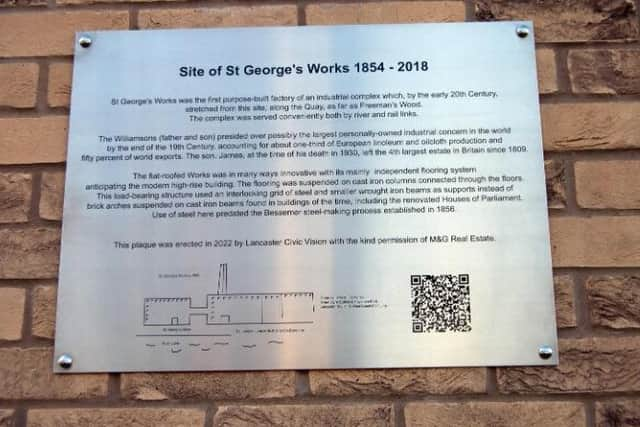Plaque unveiled to mark Lancaster site of first high-rise industrial complex in the world
and live on Freeview channel 276
A group of around 40 people from as far away as Amsterdam and Washington – and including student residents - gathered at the new Luneside student accommodation fronting St George's Quay, built in the footprint of the original complex, to witness the unveiling of the plaque by Coun Gina Dowding.
St George’s Works, built between 1854 and 1860, was the first structure of industrialist James Williamson senior and the first identifiable flat-roofed industrial building anywhere.
Advertisement
Hide AdAdvertisement
Hide AdIt produced oilcloth for floor coverings, table cloths and blinds with the fabric being manufactured on the upper floors and passed through gaps in the floors to be hung and dried in the taller space of the ground floor.


At the unveiling, Marsh ward councillor Gina Dowding said: “Lancaster has so many elements to its fascinating past and this plaque will highlight another important piece of its history on the Quay.
"The Williamsons (father and son) presided over possibly the largest personally-owned industrial concern in the world by the end of the 19th Century, accounting for about one-third of European linoleum and oilcloth production and fifty percent of world exports.
"In an article published in 1894 it was said that 'This sole company employed around 25% of Lancaster’s men and women'.
Advertisement
Hide AdAdvertisement
Hide Ad"St George’s Works was the first purpose-built factory of an industrial complex which, by the early 20th Century, stretched from this site, along the quay, as far as Freeman’s Wood.
"We really appreciate the work of Lancaster Civic Vision in highlighting these gems.”
Afterwards the group were given a tour of the external areas and gardens by manager Kirsty Astley, followed by refreshments in the communal areas of new complex.
Lancaster Civic Vision would like to thank Kirsty for her help in arranging the event as well as her assistance in erecting the sign together with negotiating permission of the building’s owners M&G Real Estate.
Advertisement
Hide AdAdvertisement
Hide AdThere is a dedicated web page to the history of St George’s Works which can be accessed via a QR code embedded into the plaque or online at http://www.lancastercivicsociety.uk/st-georges-works-st-georges-quay-lancaster-1845-to-2018/